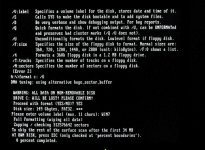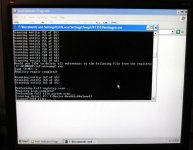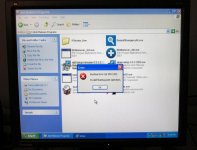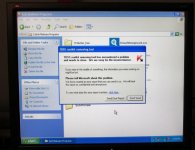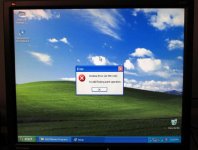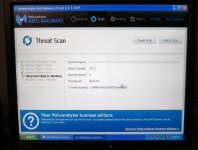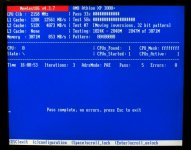How did you perform the update without internet access? In other words: Are you sure your SP3 update isn't corrupted? Are you sure the XP you're installing isn't corrupted? Have you installed both on another computer to ensure they're fine?
If you run the TDSS tool again, post what the report contains (just the screenshot is unhelpful).
Neither the XP or SP3 install disk reported any problems when scanned with AVG and MalwareBytes on this Win7 machine.
I ran the Kaspersky again on the XP machine, and as before I got an exception as soon as it was invoked. I noted that it was creating a report file in the Locals/Temp directory so I looked to see what was there. Apparently when the exception occurs two files are created; a .TXT file and a .DMP file. As soon as I closed the exception dialog both were deleted, although there were other similar files from yesterday that persisted.
I was able to make a copy of the .txt file but could not access the .dmp file to view or copy its contents. The .txt file is attached as are screen shots of the exception report, which appears to be much more detailed than the .txt file indicates, and a before and after view of the TEMP folder contents.
-CH-
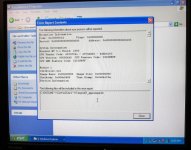
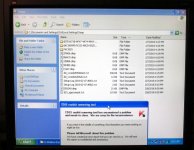

A portion of the TXT file:
<?xml version="1.0" encoding="UTF-16"?>
<DATABASE>
<EXE NAME="tdsskiller.exe" FILTER="GRABMI_FILTER_PRIVACY">
<MATCHING_FILE NAME="EmsisoftEmergencyKit.exe" SIZE="309745960" CHECKSUM="0xDCCBD3A5" MODULE_TYPE="WIN32" PE_CHECKSUM="0x12768C55" LINKER_VERSION="0x0" LINK_DATE="02/03/2016 19:38:25" UPTO_LINK_DATE="02/03/2016 19:38:25" />
<MATCHING_FILE NAME="ERARemover_x64.exe" SIZE="2991832" CHECKSUM="0xE1F0F162" BIN_FILE_VERSION="1.0.4.1" BIN_PRODUCT_VERSION="1.0.4.1" PRODUCT_VERSION="1.0.4.1" FILE_DESCRIPTION="ESET Rogue Applications Remover" COMPANY_NAME="ESET" PRODUCT_NAME="ESET Rogue Applications Remover" FILE_VERSION="1.0.4.1" ORIGINAL_FILENAME="ERARemover.exe" INTERNAL_NAME="ERARemover" LEGAL_COPYRIGHT="Copyright (c) ESET, spol. s r.o. 1992-2012. All rights reserved." VERFILEDATEHI="0x0" VERFILEDATELO="0x0" VERFILEOS="0x40004" VERFILETYPE="0x1" MODULE_TYPE="WIN32" PE_CHECKSUM="0x2DE2DD" LINKER_VERSION="0x0" UPTO_BIN_FILE_VERSION="1.0.4.1" UPTO_BIN_PRODUCT_VERSION="1.0.4.1" LINK_DATE="10/10/2012 09:37:06" UPTO_LINK_DATE="10/10/2012 09:37:06" VER_LANGUAGE="English (United States) [0x409]" />
<MATCHING_FILE NAME="ERARemover_x86.exe" SIZE="2273880" CHECKSUM="0xE741E97B" BIN_FILE_VERSION="1.0.4.1" BIN_PRODUCT_VERSION="1.0.4.1" PRODUCT_VERSION="1.0.4.1" FILE_DESCRIPTION="ESET Rogue Applications Remover" COMPANY_NAME="ESET" PRODUCT_NAME="ESET Rogue Applications Remover" FILE_VERSION="1.0.4.1" ORIGINAL_FILENAME="ERARemover.exe" INTERNAL_NAME="ERARemover" LEGAL_COPYRIGHT="Copyright (c) ESET, spol. s r.o. 1992-2012. All rights reserved." VERFILEDATEHI="0x0" VERFILEDATELO="0x0" VERFILEOS="0x40004" VERFILETYPE="0x1" MODULE_TYPE="WIN32" PE_CHECKSUM="0x232DFD" LINKER_VERSION="0x0" UPTO_BIN_FILE_VERSION="1.0.4.1" UPTO_BIN_PRODUCT_VERSION="1.0.4.1" LINK_DATE="10/10/2012 09:34:49" UPTO_LINK_DATE="10/10/2012 09:34:49" VER_LANGUAGE="English (United States) [0x409]" />
<MATCHING_FILE NAME="mb3-setup-consumer-3.3.1.2183-1.0.262-1.0.3374.exe" SIZE="83316440" CHECKSUM="0x1CD368B1" BIN_FILE_VERSION="3.3.1.2183" BIN_PRODUCT_VERSION="3.3.1.2183" PRODUCT_VERSION="3.3.1.2183 " FILE_DESCRIPTION="Malwarebytes " COMPANY_NAME="Malwarebytes " PRODUCT_NAME="Malwarebytes " FILE_VERSION="3.3.1.2183 " LEGAL_COPYRIGHT="© 2017 Malwarebytes. All Rights Reserved. " VERFILEDATEHI="0x0" VERFILEDATELO="0x0" VERFILEOS="0x4" VERFILETYPE="0x1" MODULE_TYPE="WIN32" PE_CHECKSUM="0x4F81040" LINKER_VERSION="0x60000" UPTO_BIN_FILE_VERSION="3.3.1.2183" UPTO_BIN_PRODUCT_VERSION="3.3.1.2183" LINK_DATE="01/15/2016 08:22:50" UPTO_LINK_DATE="01/15/2016 08:22:50" VER_LANGUAGE="Language Neutral [0x0]" />
<MATCHING_FILE NAME="mbam-setup-2.0.3.1025.exe" SIZE="19828376" CHECKSUM="0xDE4AFC41" BIN_FILE_VERSION="2.0.3.1025" BIN_PRODUCT_VERSION="2.0.3.1025" PRODUCT_VERSION="2.0.3.1025 " FILE_DESCRIPTION="Malwarebytes Anti-Malware " COMPANY_NAME="Malwarebytes Corporation " PRODUCT_NAME="Malwarebytes Anti-Malware " FILE_VERSION="2.0.3.1025 " LEGAL_COPYRIGHT="(c) Malwarebytes Corporation. All rights reserved. " VERFILEDATEHI="0x0" VERFILEDATELO="0x0" VERFILEOS="0x4" VERFILETYPE="0x1" MODULE_TYPE="WIN32" PE_CHECKSUM="0x12F38C5" LINKER_VERSION="0x60000" UPTO_BIN_FILE_VERSION="2.0.3.1025" UPTO_BIN_PRODUCT_VERSION="2.0.3.1025" LINK_DATE="06/19/1992 22:22:17" UPTO_LINK_DATE="06/19/1992 22:22:17" VER_LANGUAGE="Language Neutral [0x0]" />

